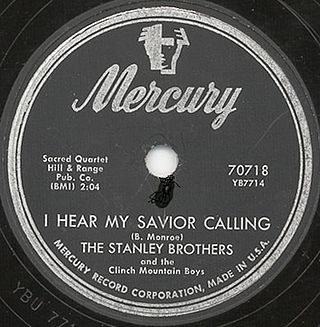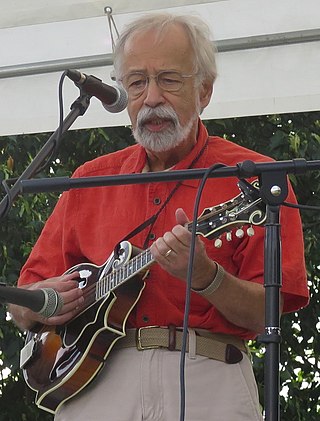Related Research Articles

The Stanley Brothers were an American bluegrass duo of singer-songwriters and musicians, made up of brothers Carter Stanley and Ralph Stanley. Ralph and Carter performed as The Stanley Brothers with their band, The Clinch Mountain Boys, from 1946 to 1966. Ralph kept the band name when he continued as a solo artist after Carter's death, from 1967 until his own death in 2016.
Longview is an American bluegrass supergroup that was formed in 1995. The group's name is derived from the Long View Recording Studio complex in North Brookfield, Massachusetts, where they recorded their first album.

James Dee Crowe was an American banjo player and bluegrass band leader. He first became known during his four-year stint with Jimmy Martin in the 1950s. Crowe led the bluegrass group New South from 1971 until his death in 2021.

Flatt and Scruggs were an American bluegrass duo. Singer and guitarist Lester Flatt and banjo player Earl Scruggs, both of whom had been members of Bill Monroe's band, the Bluegrass Boys, from 1945 to 1948, formed the duo in 1948. Flatt and Scruggs are viewed by music historians as one of the premier bluegrass groups in the history of the genre.

The Grascals are a six-piece American bluegrass band from Nashville, Tennessee. Founded in February 2004, the band has gained a level of fame by playing on the Grand Ole Opry and bluegrass festivals around the country, as well as with Dolly Parton.

Roland Joseph White was an American bluegrass music artist, performing principally on the mandolin. He was inducted into the International Bluegrass Music Hall of Fame in 2017.
Missy Raines is an American bassist, singer, teacher, and songwriter. She has won 10 International Bluegrass Music Awards for Bass Player of the Year. Missy Raines was the first woman to win IBMA Bass Player of the Year award. She won 1998, 1999, 2000, 2001, 2004, 2006, 2007, 2019, 2020, and 2021.
Allen Shelton was an American five-string banjo player mostly known for being a member of the bluegrass band Jim & Jesse and the Virginia Boys since the 1960s. Shelton was born in Rockingham County, North Carolina, on July 2, 1936. Shelton started playing the banjo when he was fourteen. His father Troy Shelton was a guitar player mainly, but also played mandolin and banjo. A local musician named Junior Biggs showed him some three-finger style rolls.
Lynn Morris is an American bluegrass musician.

Bernarr Graham Busbice, known professionally as Buzz Busby, was an American bluegrass musician, known for his mandolin style and high tenor voice. He was nicknamed the "Father of Washington, D.C. Bluegrass".
Donald Glen Rigsby is an American mandolinist, fiddler, guitarist, vocalist, and producer in the bluegrass tradition. He is known for his solo career, and for his work with the Lonesome River Band and Longview.
James Elroy King was an American bluegrass music singer. Tom T. Hall dubbed King the “Bluegrass Storyteller,” for his ability to infuse his story songs with emotion and authenticity.
Dudley Dale Connell is an American singer in the bluegrass tradition. He is best known for his work with the Johnson Mountain Boys, Longview, and The Seldom Scene.
Marshall Wilborn is an American bluegrass music bass player and composer best known for his work with the Johnson Mountain Boys, Longview, Michael Cleveland and Flamekeeper, and the Lynn Morris Band.
David McLaughlin is an American multi-instrumentalist. His mandolin prowess has helped clarify how Bill Monroe's style of playing can be applied to progressive bluegrass music.
Ron Stewart is an American multi-instrumentalist in the bluegrass tradition. He plays fiddle, guitar, banjo, and mandolin, and has won the International Bluegrass Music Association (IBMA) award for Fiddle Player of the Year in 2000 and Banjo Player of the Year in 2011.
Patrick Coleman McAvinue is an American fiddler, combining in his music aspects of bluegrass, swing, and Celtic music. He is also a private music educator. He is the IBMA's 2017 Fiddle Player of the Year.

Rickie Hal Simpkins is an American fiddler and mandolinist in the bluegrass tradition. He is best known for his solo albums and his work with the Lonesome River Band and the Seldom Scene.
Herschel Lee Sizemore was an American mandolinist in the bluegrass tradition.
References
- 1 2 3 4 5 6 7 Rice, Wayne (1988–2007). "BluegrassBios: I - J". Archived from the original on 2008-02-24.
- 1 2 Harrington, Richard (1988-03-06). "Singing the Blues for Bluegrass;As interest in The Music Fades, Even the Award Winning Johnson Mountain Boys Seek Out Alternative Careers". Washington Post .
- ↑ "2020 winners of the International Bluegrass Music Awards". 2 October 2020.
- ↑ "Overview: The Johnson Mountain Boys (1981)", Allmusic





- ↑ Humpphrey, Mark A. "Review: Working Close". Allmusic




 .
. - 1 2 3 Owens, Thom. "Review: At the Old Schoolhouse". Allmusic




 .
. - ↑ Harrington, Richard (1988-06-08). "Bittersweet Bluegrass Finale". Washington Post . Retrieved 2019-04-21.
- 1 2 Joyce, Mike (1991-01-04). "Johnson Boys' Bluegrass Return". Washington Post . Retrieved 2019-04-21.
- ↑ Loftus, Johnny. "Biography: The Johnson Mountain Boys". Allmusic .
- ↑ Owens, Thom. "Review: Blue Diamond". Allmusic




 .
. - ↑ Joyce, Mike (1993-02-26). "The Boys Are Back In (Lots of) Tunes". Washington Post . Retrieved 2019-04-21.
- ↑ Parsons, Penny (September 2000). "Dudley Connell: Making Magic with Music"". Bluegrass Unlimited . Vol. 35, no. 3. pp. 30–36.